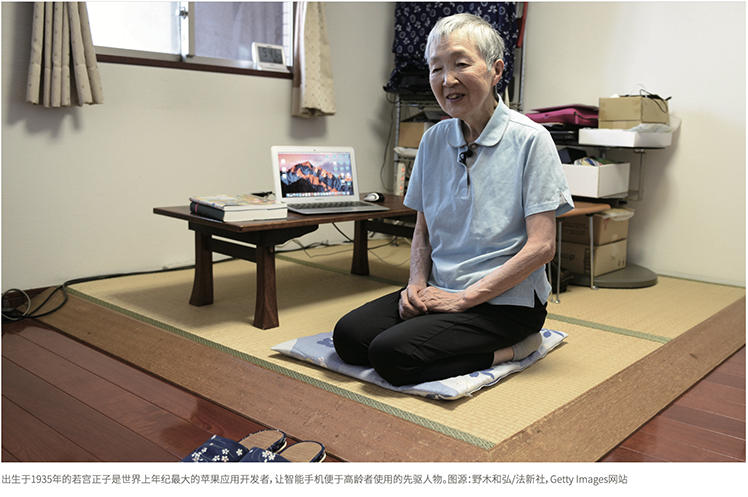Work in the Era of No Retirement

提起五十岁以上的员工,你想到的或许是即将退休的人,在现代办公室格格不入的人,没有多少兴趣学习新的工具和技术。
When you think of workers in their fifties and older, you might imagine people nearing retirement and out of place in the modern office, with little interest in learning new tools and technologies.
其实并不是这样。年长员工不是没用的跛脚鸭子,也不是旧时代的遗迹。员工团队中的年长群体其实不能简单地划为一个群体——这些员工类型不同,背景、经历和期望都不同。未来很长一段时间里,你会看到他们出现在在办公室、商店乃至制造业领域。
You’d be wrong. Older workers aren’t lame ducks or relics. The older segment of the workforce isn’t actually one segment; the demographic includes many types of workers — with diverse backgrounds, experiences, and desires — that you can expect to see around the office, at the store, and even in manufacturing fields for a long time to come.
全世界几乎所有地方的人口结构都在向老龄化发展。1950年65岁以上人口占总人口数的5%,据联合国世界人口展望报告(World Population Prospects)2019年修订版显示,预计到2050年这个比例将增长到16%。仅美国每天就有一万人满65岁,65岁及以上的美国人数量在1950年约为1300万,现在约5800万,至2060年将达到近9500万。人类寿命自20世纪初开始大幅度增加,只有2020年初新冠疫情导致许多人丧生。现在健康的65岁老人可以活到接近90岁。长寿方面的专家认为本世纪出生的孩子可以为活到一百岁做准备。
Nearly everywhere in the world, the population is skewing much older than ever before. People over 65 composed 5% of the world’s population in 1950, but this percentage is expected to increase to 16% by 2050, according to data from World Population Prospects: the 2019 Revision. In the United States alone, 10,000 people turn 65 every day, and the number of Americans ages 65 and older, which was about 13 million in 1950, is about 58 million today; by 2060, nearly 95 million Americans will be 65 and older. Life spans have increased sharply since the early 20th century, except for the tragic loss of life since early 2020 due to the Covid-19 pandemic. Today, a 65-year-old in good health can expect to live to nearly 90. Experts in longevity believe that kids born this century should prepare to live to 100.
也许更重要的是,健康寿命长度,即生活不需要护理的时期也增长了。人们在六十岁、七十岁乃至八十岁都能保持健康,就能比以前多工作几年。其实再过两年,劳动人口中就会有接近25%的55岁及以上员工。其中一些人选择继续工作,还有一些人会因为在20岁至65岁期间赚到的钱不足以维持到90岁的生计而继续工作。活到90岁的人需要的资金比活到70岁多得多。
Perhaps more important, health spans — a term used to describe the years one can live without requiring care — are getting longer, too. And because people stay healthier into their sixties, seventies, and even eighties, they are working for many more years than ever before. In fact, just two years from now, nearly 25% of the workforce will be 55 and older. Some of these workers choose to work until later ages, while others keep working because they can’t earn enough between the ages of 20 and 65 to support themselves if they live to be 90. The financial demands on someone who lives to be 90 are far greater than those experienced by someone who only lives to be 70.
55岁及以上群体是美国劳动人口中增长最快的群体,然而这个群体却被广泛误解。我们谈论年长员工的话语中,充斥着根深蒂固的误解和刻板印象,以及毫不掩饰的年龄歧视。
People ages 55 and older are the fastest-growing segment of the American workforce, yet they are wildly misunderstood. Persistent myths and stereotypes, along with straight-up ageism, pervade how we talk about older workers.
这种状况需要改变。
We need to change the discourse.
员工长寿不是问题,而是机遇。但要从年长员工的个人经验和充沛精力中获益,企业必须做好准备,建立基础设施和系统吸引这部分员工并提供支持。
Workers’ longevity is not a problem but an opportunity. To benefit from these individuals’ experience and energy, however, your organization must be “age ready” — which means building infrastructure and systems to support and engage them.
长期存在的年龄歧视
Ageism’s Persistence
研究表明,年龄歧视在工作场所和求职市场广泛存在。例如在大萧条期间,年长员工受到的负面影响尤其严重。与年轻员工相比,55岁及以上人群中经历长期失业的人更多,失业时间更长,更容易接受薪水低于前职的工作。
Studies confirm that ageism is widespread in the workplace and the job market. During the Great Recession, for instance, older workers in particular were negatively affected: A larger percentage of those ages 55 and older experienced long-term unemployment compared to younger workers, they were displaced longer, and they were more likely to reenter the workforce at a lower salary than in their previous job.
还不止这些。
There’s more:
- 超过9/10的年长员工认为对自己年龄层的歧视比较普遍或非常普遍。
- 3/5的年长员工表示自己在工作场所见过或经历过年龄歧视。
- 担心下一年丢掉工作的年长员工有1/3认为年龄歧视是可能导致自己失业的主要或次要原因。
- 44%的年长求职者表示在申请或面试阶段被问过年龄相关的问题。
- 只有3%的员工表示自己正式向上司、人力资源负责人、其他组织或政府机构投诉过年龄歧视问题。
- 近3/5的年长员工强烈支持加强法律监督防止年龄歧视。
- More than nine in 10 older workers see discrimination against people in their age group as somewhat or very common.
- Three out of five older workers report that they have seen or experienced age discrimination in the workplace.
- One-third of those concerned about losing their job in the next year list age discrimination as either a major or minor reason they expect this to occur.
- Among job seekers, 44% of older job applicants say they have been asked for age-related information during the application or interview process.
- Only 3% of workers report that they have made a formal complaint of ageism to a supervisor, a human resources representative, another organization, or a government agency.
- Nearly six in 10 older workers strongly support strengthening laws to prevent age discrimination.
在关于这个问题的一篇学术论文中,斯坦福商学院教师阿什利·马丁(Ashley Martin)和纽约大学的迈克尔·诺思(Michael S. North)称年龄歧视是最不能姑息的歧视。这个领域的研究者发现了两个造成年龄歧视的普遍误解。
In a research paper on the topic, coauthors Ashley Martin, a faculty member at the Stanford Graduate School of Business, and Michael S. North of New York University describe ageism as the last acceptable ism. Researchers in the field have identified two common myths that contribute to ageism.
误解之一,雇用年长员工的成本更高,而且无法增加价值。这种误解部分源自一种普遍的观念——年长员工的薪水和福利比年轻员工高。另一种普遍观念是有经验的员工效率较低,带来的价值更少。
Myth #1: Older workers are more costly and don’t add value. Part of this myth stems from a commonly held belief that salaries and benefits for older employees exceed those for younger employees. Another common perception is that experienced workers are less productive and add less value to the workplace.
事实上,年长员工可以从其他员工无法实现的角度为雇主降低成本、增加价值。例如新冠疫情流行期间,数万名退休的医护人员返回工作岗位,用来形容他们的是经验丰富、睿智、必不可少、可信赖这样的词语。就业咨询公司美世的调查中也能看到年长员工的价值。调查发现,年长员工在工作场所的情商更高,且能降低成本,因为他们不太会自行离职,负责的团队内人员流失率也更低。年长员工对于建立知识分享和指导的环境至关重要,而且研究表明,年长员工能够增强团队凝聚力、合作和韧性。
In reality, older workers reduce costs for employers and add value in ways other workers do not. During the Covid-19 pandemic, for instance, tens of thousands of retired health care professionals returned to work in hospitals, with words like experienced, wise, essential, and trusted used to describe them. Their value can also be seen in employment consulting firm Mercer’s research, which has found that older workers bring an extra level of emotional intelligence to the workplace; additionally, older workers reduce costs because they are less likely to leave voluntarily and have lower turnover rates on teams they supervise. Older workers are crucial to creating environments with knowledge sharing and mentoring, and studies suggest that their presence strengthens group cohesion, collaboration, and resiliency.
这些员工还能为创新做贡献。高龄群体是世界上增长最快的群体,据估计全球有22万亿,美国近8万亿。几乎每一个行业的公司都需要照顾年长客户的战略,而年长员工可以参与构思和开发这类产品及服务并推向市场。瓦尔比派克等公司已经开始进行战略改变。这家直接面向消费者的眼镜公司,最初致力于吸引年轻人,但在进入年长者用的渐进多焦点镜片市场后,获得了大规模增长。这个支点要求公司为年长者市场制定战略,包括在目标市场进行招募和咨询。公司了解了高龄客户(也就是老年人)想要什么——价格实惠的时髦镜片——与通常对这一群体需求的预设不同。高龄者市场还有一组词语专门形容基于“老年人不在乎时尚或外表”这一错误预设的糟糕产品设计:大、米色、无聊。
These workers also contribute to innovation. The longevity sector is the fastest-growing sector in the world, estimated at $22 trillion globally and nearly $8 trillion in the United States. In virtually every industry, companies need a strategy for catering to older customers, and older employees can play a role in conceptualizing and developing products and services and bringing them to the market. A change in strategy is already happening at companies such as Warby Parker, which started as a direct-to-consumer eyewear brand that appealed to young adults but generated massive growth when it entered the market for progressive lenses for older people. Warby Parker’s pivot required the company to generate a strategy for the market, including hiring and consulting people in the target market. The company learned what longevity customers (that is, older adults) wanted — fashionable frames at affordable prices — which differed from common assumptions about what these customers wanted. In the longevity market, there’s even a term to describe the poor product designs that are based on the misguided assumption that older adults don’t care about fashion or visual appeal: big, beige, and boring.
误解之二:年长员工很难掌握新技术。这一观念被一些科技产品的营销活动强化,但老态龙钟的老人用不来手机,完全是一种年龄歧视的想象。很多年长员工能够熟练使用科技产品,新冠疫情流行更是在年长员工中激起了学习数字化技术的热潮,因为他们也像我们所有人一样被迫转为在线办公。远程工作在无意间实现了一种均衡,让所有员工都能更加熟练地使用未来工作场所需要的技术。
Myth #2: Older workers struggle with technology and new skills. This belief is reinforced by some marketing campaigns for tech products, but the image of a doddering old person unable to work their phone is an ageist trope. Many older workers are fluent in technology, and the pandemic provoked a spike in digital skills acquisition among older adults, who, like all of us, were forced into a Zoom world. Working remotely may have inadvertently become a great equalizer as well, as all workers became more fluent in the technology needed to thrive in the emerging workplace.
虽然技能上的差异的确存在,但这是可以填补的。美世公司的研究表明,有经验的员工并不是学不会新技能,而是较少获得这方面的指导,或者缺乏独立尝试这类技能和技术的机会。虽然年轻人比年长者更有可能在早期适应使用技术,但过去十年来年龄最大的群体中掌握关键技术的比例也有所提升。最重要的是,年长者像其他年龄层的人一样希望学习新技术。
Where skills gaps do still exist, they can be filled. The reality is not that experienced workers can’t learn new skills; rather, they are less likely to have been taught or independently experimented with these skills and technologies already, according to Mercer’s research. While younger adults are more likely than older adults to be earlier adopters of technology, there has been an increase in the adoption of key technologies by those in the oldest age groups over the past decade. Most important, older adults want to learn new technologies, just like other generations.
组织不应当再关注年长员工不知道什么,而是要考虑能提供怎样的技能培训,充分调动员工学习和贡献的意愿。宝马、百思买、Salesforce和谷歌等公司为所有年龄层的员工提供保持数字素养的机会,年长员工的学习效率和成果都非常显著。美国退休人员协会(AARP)与谷歌合作,帮助50岁以上的低收入人员(特别是女性和有色人种)提升数字化技术,项目在八个州开展,计划推广到全美。
Organizations should stop focusing on what older workers don’t know and instead consider what upskilling and training they can offer to maximize workers’ desire to learn and contribute. Companies such as BMW, Best Buy, Salesforce, and Google provide opportunities for employees of all ages to maintain digital literacy, and they have seen great uptake and results from older workers. AARP and Google are collaborating to help low-income workers over 50 — particularly women and people of color — improve their digital skills. The program is set to launch in eight states, with plans to scale it to a national level.
高龄的未来
The Longevity Future
高龄问题专家说,破除以上误解的努力可以“把年龄歧视转为对智者的尊重”。专家认为,组织应当意识到年长员工可以贡献自己的人生经验和知识,应当加以利用并予以奖励。企业应当在董事会、员工群体、广告和营销活动中纳入这一观点。今后几年里员工和消费者中都会有数量空前的老年人,拒绝这种做法就太愚蠢了。
Longevity experts like to say that these myth-busting efforts are “turning ageism into sageism.” These experts believe organizations should recognize, reward, and reap the value that older employees can contribute thanks to their life experiences and knowledge. Companies should embrace this point of view in their boardrooms, workforce, and advertising and marketing campaigns. Given the unprecedented number of older adults who will be both employees and consumers in the coming years, it would be foolish not to.
苏珊·威尔纳·戈尔登即将出版新书《阶段(而非年龄)》[Stage (Not Age)],讲述长寿创造的机遇。她是斯坦福杰出事业研究所dciX项目负责人,斯坦福商学院讲师。
苏珊·威尔纳·戈尔登(Susan Wilner Golden)| 文





